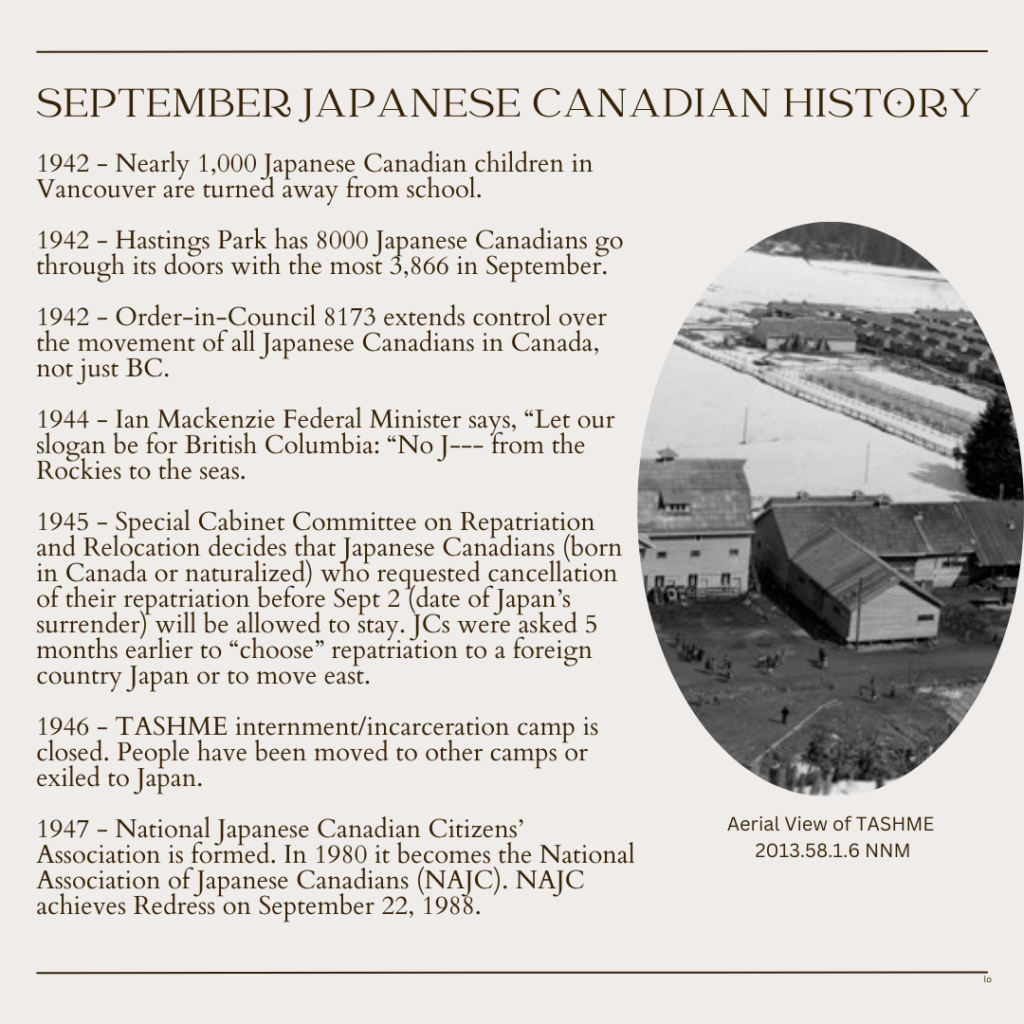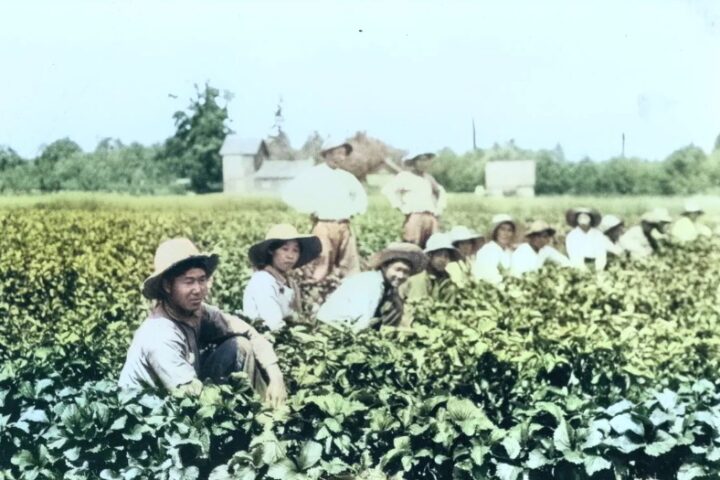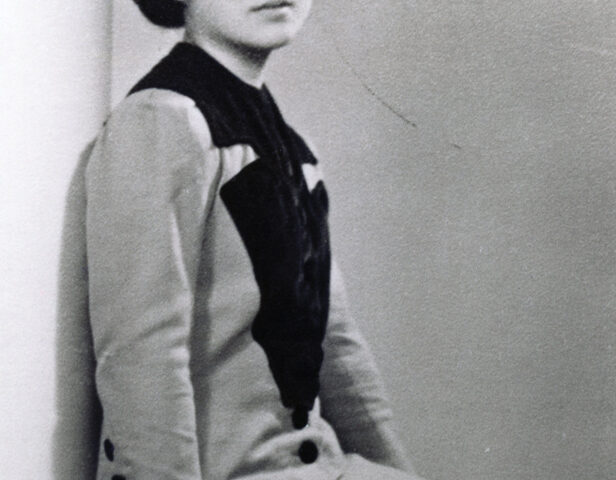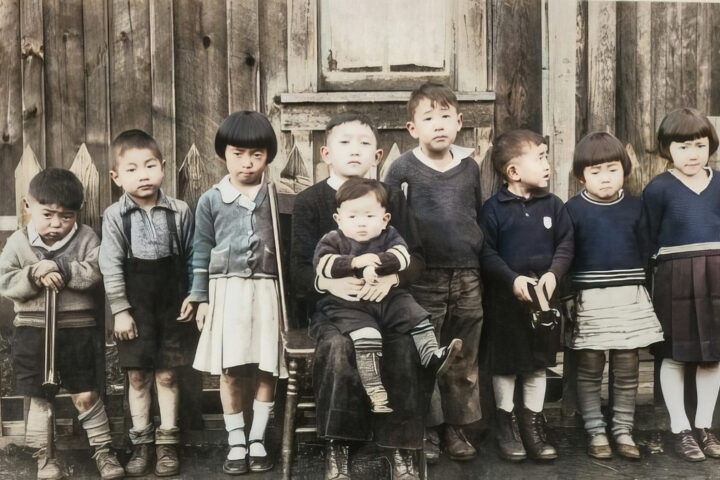Highlights of September Dates in Japanese Canadian History
By Lorene Oikawa, Past President NAJC
In 2023, the National Association of Japanese Canadians (NAJC) is reviewing the highlights of dates for each month, from the period 1941 to 1949. We are looking at the actions of government and the impact on Japanese Canadians.

1942 – September 1. The Vancouver Province newspaper’s headline was “City’s Strangest “First Day.”” Nearly 1,000 children of Japanese ethnicity residing with their families in Vancouver showed up to school only to be turned away. There wasn’t any prohibition decided by the federal government. The Vancouver School Board declared it “a highly impractical” process to have Japanese Canadian children be enrolled only to be pulled after about six weeks leaving them with additional teachers who were employed and then no longer needed.
Education was listed in the British North America Act under Section 93 and identified as a provincial responsibility. The Security Commission also thought the province should accept their responsibility because Japanese Canadians were still residents of the province and only moved within the province. BC’s Minister of Education, H.G.T. Perry proposed a change to the legislation to prohibit Japanese Canadians from BC’s school system. Japanese Canadians were left to figure out the education for their children. They started with temporary classes in Hastings Park and the camps.
High school students had to pay for their correspondence courses. High schools didn’t open until September 1943 in New Denver when 50 Nisei resumed classes.
Grace Woodsworth MacInnis (her husband Angus MacInnis was the Co-operative Commonwealth Federation (CCF) MP for Vancouver East) went on a speaking tour to gather support for schools in the incarceration camps. The Co-operative Commonwealth Federation (CCF) was the precursor to the NDP. Churches (Roman Catholic, Anglican and United) started to step up by setting up temporary schools. There was pressure on the Security Commission to take responsibility and set up schools.
1942 – September 1. At this point, Hastings Park would have the most Japanese Canadians crammed into the livestock barns and other buildings. 3,866 persons. A total of 8,000 Japanese Canadians who lived outside of Metro Vancouver would be sent to Hastings Park to stay until being moved to more permanent locations. The buildings at Hastings Park were quickly made over in the week before the first arrival of Japanese Canadians in March.
1942 – September 8. Order-in-Council P.C. 8173 extends the control over the movement of all Japanese Canadians in Canada, not just in BC. For example, Albertans of Japanese ethnicity are now required to have a permit to travel more than 12 miles. They have to seek approval if they want to move or sell their home, buy property or enter British Columbia. All of their mail and telephone calls are censored.
1942 – September 8. TASHME internment/incarceration camp receives the first large group of Japanese Canadians. Japanese Canadians started arriving in July 1942. It’s the largest of the internment/incarceration camps and the last to be opened. The peak population of the camp including administration and RCMP is 2,690 in 1943. TASHME is about a three-hour drive from Vancouver and located 14 miles southeast of the village of Hope. The name is made up of the first two letters of the last names of Taylor, Shirras, and Mead who were the Security Commissioners
1944 – September 18. Ian Mackenzie, Minister of Pensions and National Health says, at a nomination meeting, “Let our slogan be for British Columbia: “No J— from the Rockies to the seas.”
1945 – September 2. The date of unconditional surrender of Japan was used as the threshold date for Japanese Canadians born in Canada and naturalized citizens who applied to have their repatriation application cancelled before that date, they would be allowed to remain in Canada. For those who were born in Japan, they would be denied. This was decided at a September 5, 1945, Special Cabinet Committee meeting. See September 5 entry. In spring of 1945, the federal government had started a programme of dispersal which offered Japanese Canadians the “choice” of applying for voluntary repatriation to Japan or go “east of the Rockies.” The federal government was interested in retaining their political power and appealed to the racist wishes of British Columbian politicians such as Howard Green and Tom Reid who wanted the deportation of all Japanese Canadians.
Most Japanese Canadians were born in Canada. Some of the younger Japanese Canadians out of duty or dependency would have to follow the wishes of their elders. Some elders felt betrayed by their country and thought it would be better to leave the racism and injustice. However, Japan was struggling with the aftermath of the bombs and war, and it was hard for them to take on Canadians who were essentially foreigners in Japan. There were a lot of rumours and misinformation, and some believed if they didn’t sign repatriation papers, they would be homeless and without food. By the end of the war, there were 4,720 persons who wanted to withdraw their repatriation applications.
1945 – September 5. Special Cabinet Committee on Repatriation and Relocation (formerly known as the Cabinet Committee on Japanese Questions) meets. The Labour Minister Humphrey Mitchell wants to pass three Orders-in-Council under the War Measures Act. The OICs would make any repatriation application binding on those who signed and their families, strip them of their citizenship, and set up a loyalty commission which would have the power to decide which Japanese Canadians would be allowed to remain on compassionate grounds. Mitchell was backed by Ian Mackenzie, but three new members on the committee refused to accept that all Japanese Canadians should be deported. They have had regular contact with senior officers of the Canadian military and police who believed in the loyalty and innocence of Japanese Canadians from the beginning. However, they accepted a compromise that would waive the repatriation applications from Canadian born and naturalized citizens if they had requested cancellation before September 2. Also, they wanted General Douglas MacArthur, Supreme Allied Commander in Japan to advise when repatriation could start. This delay stalled Mitchell’s plan to have the Orders-in-Council under the War Measures Act and prevent any parliamentary interference. The War Measures Act was set to expire January 1, 1946, and would be replaced by the National Emergency Powers Act. Under the new act, parliament could stop any Orders-in-Council and the government feared the CCF would attempt to stop the deportation.
1946 – September. TASHME is closed. After the peak population of 2,100 Japanese Canadians and other non-JC residents reached 2,690 in 1943, the numbers started to decrease as Japanese Canadians were moved to other camps or exiled to Japan.
1947 – September 17. Justice Minister Ilsley faced with the possibility of a boycott of the Royal Commission and publicity about a boycott by Japanese Canadians, convinced the Cabinet to open the terms of the Royal Commission to “include all property disposed of by the Custodian or stolen while in the custody of the Custodian or of an agent appointed by him.” This would put the implementation of the policy under scrutiny, but not the policy.
The Royal Commission had been set up two months earlier under Order-in-Council P.C. 1810 with Commissioner Justice Henry Bird of the British Columbia Supreme Court. The terms were outrageously limiting, and it led to protests from Japanese Canadians and their allies.
1947 – September. After dealing with the deportation crisis and now with the Royal Commission, Japanese Canadian associations across Canada realized there would be strength in uniting all the groups to fight for their rights. Chapters formed under the newly created National Japanese Canadian Citizens’ Association. The NJCCA coordinated the claims procedure. In 1980, the NJCCA became the National Association of Japanese Canadians (NAJC) and took another lead role in achieving Redress which was announced by the Prime Minister on September 22, 1988.



